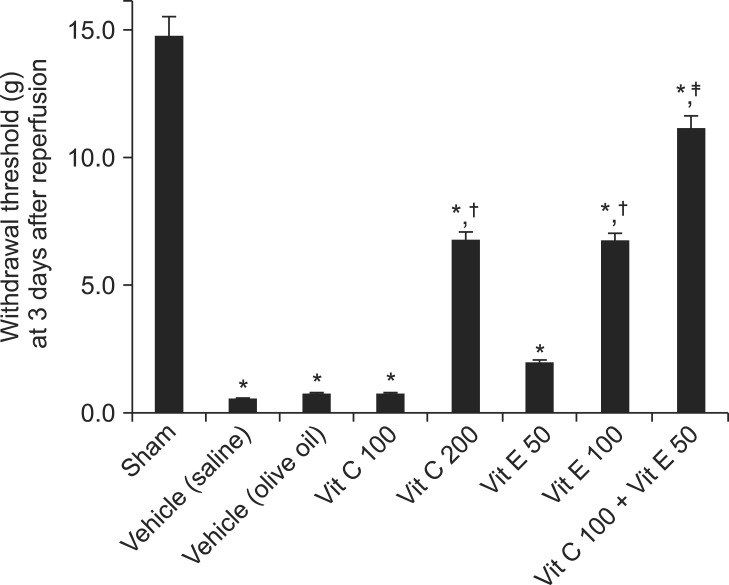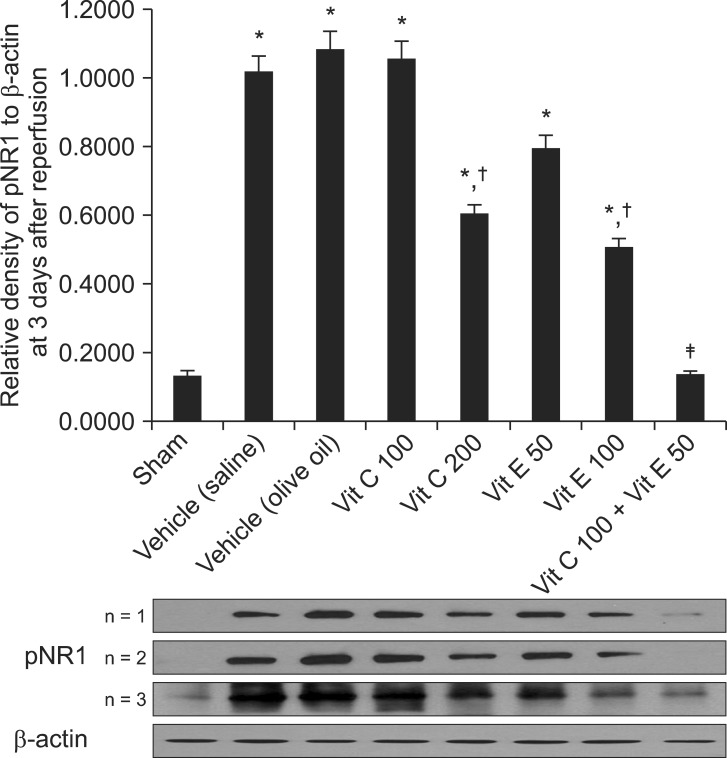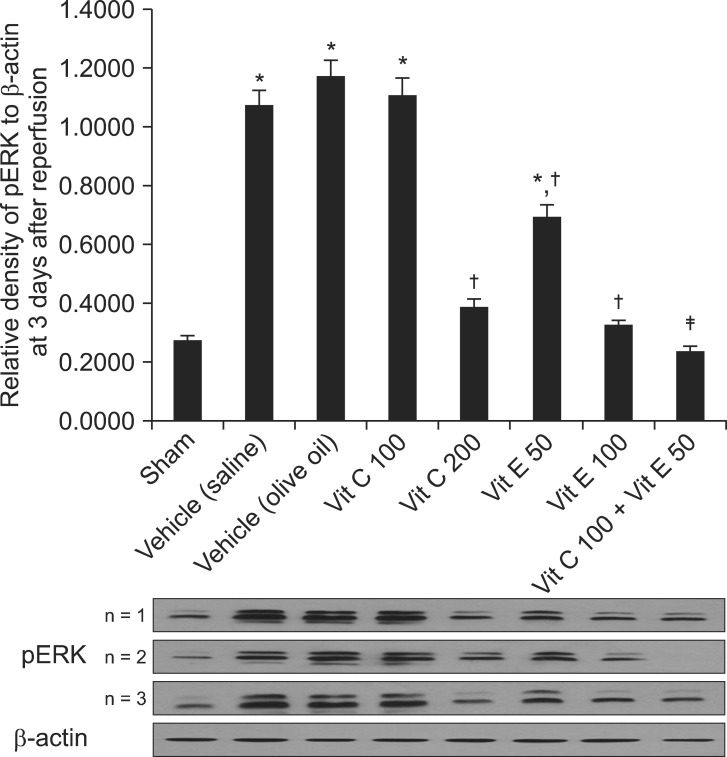Introduction
Materials and Methods
Animals
Drug treatment
Hindpaw ischemia/reperfusion
Test for sedation
Behavioral test
Western blot analysis
Statistical analysis
Results
Behavioral test
 | Fig. 1Left-sided von Frey withdrawal thresholds for mechanical allodynia at 3 days after reperfusion. Vitamin C 200 and vitamin E 100 groups showed statistically significant antiallodynic effects relative to vehicle (saline) and vehicle (olive oil), respectively (P < 0.01), although mechanical thresholds were not normalized to that of the sham (P < 0.01). Vitamin C 100 + vitamin E 50 group showed a statistically significant antiallodynic effect relative to the vitamin C 100 and vitamin E 50 groups (P < 0.01), although the mechanical threshold was not normalized to that of sham (P < 0.01). Data are presented as means ± SEM. Sham rats (n = 6), vehicle (saline), saline treatment (n = 6), vehicle (olive oil), olive oil treatment (n = 6), vit C 100, vitamin C 100 mg/kg treatment (n = 6), vit C 200, vitamin C 200 mg/kg treatment (n = 6), vit E 50, vitamin E 50 mg/kg treatment (n = 6), vit E 100, vitamin E 100 mg/kg treatment (n = 6), vit C 100 + vit E 50, vitamin C 100 + vitamin E 50 mg/kg treatment (n = 6). *P < 0.05, vs. sham group. †P < 0.05, vs. the vehicle (saline) or vehicle (olive oil) groups. ‡P < 0.05, vs. the vit C 100 or vit E 50 groups. |
Western blot analysis
 | Fig. 2Western blot data showing the relative densities of pNR1 to β-actin at 3 days after reperfusion. The relative densities of pNR1 in the vitamin C 200 and vitamin E 100 groups decreased significantly compared with those of the vehicle (saline) and vehicle (olive oil), respectively (P < 0.05 and P < 0.01, respectively), although the relative densities of pNR1 in the vitamin C 200 and vitamin E 100 groups were significantly higher compared with that of the sham group (P < 0.01 and P < 0.05, respectively). The relative density of pNR1 in the vitamin C 100 + vitamin E 50 group decreased significantly compared with those of the vitamin C 100 and vitamin E 50 groups (P < 0.01). Data are presented as means ± SEM. Sham rats (n = 3), vehicle (saline), saline treatment (n = 3), vehicle (olive oil), olive oil treatment (n = 3), vit C 100, vitamin C 100 mg/kg treatment (n = 3), vit C 200, vitamin C 200 mg/kg treatment (n = 3), vit E 50, vitamin E 50 mg/kg treatment (n = 3), vit E 100, vitamin E 100 mg/kg treatment (n = 3), vit C 100 + vit E 50, vitamin C 100 + vitamin E 50 mg/kg treatment (n = 3). *P < 0.05, vs. the sham group. †P < 0.05, vs. the vehicle (saline) or vehicle (olive oil) groups. ‡P < 0.05, vs. the vit C 100 or vit E 50 groups. |
 | Fig. 3Western blot data showing the relative densities of pERK to β-actin at 3 days after reperfusion. The relative density of pERK in the vitamin C 200 and vitamin E 100 groups decreased significantly compared with those of the vehicle (saline) and vehicle (olive oil), respectively (P < 0.01). The relative density of pERK in the vitamin C 100 + vitamin E 50 group decreased significantly compared with those of the vitamin C 100 and vitamin E 50 groups (P < 0.01). Data are presented as means ± SEM. Sham rats (n = 3), vehicle (saline), saline treatment (n = 3), vehicle (olive oil), olive oil treatment (n = 3), vit C 100, vitamin C 100 mg/kg treatment (n = 3), vit C 200, vitamin C 200 mg/kg treatment (n = 3), vit E 50, vitamin E 50 mg/kg treatment (n = 3), vit E 100, vitamin E 100 mg/kg treatment (n = 3), vit C 100 + vit E 50, vitamin C 100 + vitamin E 50 mg/kg treatment (n = 3). *P < 0.05, vs. the sham group. †P < 0.05, vs. the vehicle (saline) or vehicle (olive oil) groups. ‡P < 0.05, vs. the vitamin C 100 or vitamin E 50 groups. |




 PDF
PDF Citation
Citation Print
Print


 XML Download
XML Download